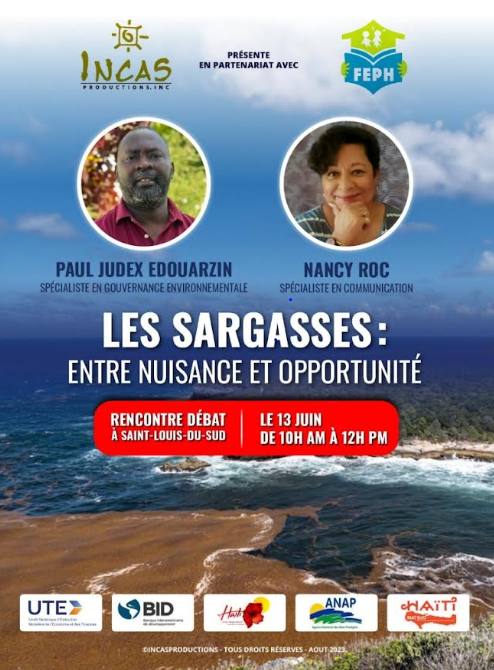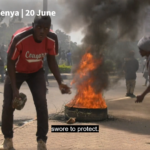By Nancy Roc and Paul Judex Edouarzin
Submitted to AlterPresse on June 20, 2024
As part of the Sustainable Coastal Tourism (Tcd) program, financed by the Inter-American Development Bank (Bid), the Technical Execution Unit of the Ministry of Economy and Finance (Ute/Mef) – in partnership with the Ministry of Tourism and the Ministry of the Environment/National Agency for Protected Areas (Anap) – supports activities to prevent natural disasters and climate change, aimed at children and adolescents in the South, a project proposed by the Haitian firm , Incas Productions.
In partnership with the Federation of Protestant Schools of Haiti (Feph), Incas Productions raised awareness among nearly 600 students during webinars on Thursday June 13 and Friday June 14, 2024 in Saint-Louis du Sud, on the theme “Sargassum: between nuisance and opportunity”, and in Aquin, on the theme “Young people facing climate disasters: what resilience? »

Since 2011, sargassum has invaded southern Haiti.
These algae, although natural, proliferate alarmingly. This proliferation would be associated with global warming and nutrient discharges into the Atlantic Ocean.
Mass strandings of these large brown algae could be attributed to nitrate discharges from the Amazon River, according to researchers at the University of South Florida. [[1] .
Marine currents, exacerbated by extreme weather phenomena, transport these masses of algae across the Caribbean and also onto Haitian beaches, creating a major problem for residents.
Indeed, whether in Saint-Louis-du-Sud and Les Cayes (South) or in Jacmel (South-East), sargassum poses a serious threat to public health in Haiti, particularly for children.
Their massive proliferation transforms beaches into veritable marine dumpsites. The effects on health are multiple.
For example, when decomposing, sargassum releases hydrogen sulphide, a toxic gas responsible for respiratory problems, skin irritations and headaches.
In addition, tourists in the Caribbean – there are no longer any in Haiti, due to political instability, insecurity and armed gang violence – avoiding infested beaches, cause significant economic losses for local communities, dependent on tourist activities.
The harmful effects
Whether in Saint-Louis-du-Sud and Les Cayes or in Jacmel, by invading the coasts, the gases emitted by the decomposition of sargassum can cause respiratory irritation, nausea and other health problems for communities, especially children, living near affected areas.
Sargassum disrupts local marine ecosystems and the life cycle of certain species, suffocating marine fauna and flora: fish asphyxiation, inaccessibility of marine turtles to nesting sites. Coral reefs, essential to marine biodiversity and the protection of coastlines against erosion, are particularly affected because they are deprived of light.
In addition, the decomposition of sargassum, by releasing hydrogen sulfide, contributes to the acidification of waters, endangering marine species and fishing, a vital resource for Haiti’s coastal communities.
Fishing boats, hampered by piles of algae, struggle to navigate, compromising the livelihood of local fishermen.
Faced with this ecological crisis, it is imperative that Haitian authorities, in partnership with regional and local organizations, develop sustainable management and effective cleanup strategies to preserve the ecological balance and support threatened local economies.
An untapped opportunity in Haiti
While sargassum represents a threat to tourism and the marine ecosystem, it also offers a multitude of economic and environmental opportunities.
Many initiatives in the Caribbean demonstrate how sargassum can be transformed into a valuable resource, and Haiti could benefit greatly from these innovations.
In many regions of the Caribbean, sargassum is used as an organic fertilizer.
For example, in Puerto Rico [[2]farmers have started to integrate sargassum into compost, thus improving soil quality and reducing the use of expensive chemical fertilizers.
In Saint Lucia, the company Algas Organics transforms sargassum into biofertilizers [[3]. Their business model shows how sargassum can be transformed into value-added products, creating local jobs and supporting sustainable agriculture.
Haiti could adopt this practice to revitalize its degraded and depleted soils, and increase agricultural productivity, while nearly five million Haitians suffer from hunger and need food aid, according to recent figures from the United Nations (UN) [[4].
In Martinique, sargassum is used to make ecological building materials, such as bricks and insulating panels. [[5]. These products are not only durable, but also economical.
In Haiti, where reconstruction after natural disasters is a priority, using sargassum to produce construction materials could represent a significant advance.
Sargassum can also be transformed into biofuel.
In Mexico, an innovative company has developed a process to convert these algae into biomethane, a renewable energy source [[6].
This technology could be a viable solution for Haiti, which seeks to diversify its energy sources and reduce its dependence on imported fossil fuels.
Sargassum is also rich in bioactive compounds, used in the cosmetic and pharmaceutical industries.
In Guadeloupe, a company has succeeded in extracting anti-inflammatory and antioxidant substances from sargassum to create skin care products [[7].
Haiti, with its development potential in the natural cosmetics sector – cf. Castor oil (Maskriti), to cite just one example – could exploit this resource to create high value-added products.
The challenges to be met
Despite the opportunities, several challenges must be addressed to maximize the use of sargassum in Haiti.
Seasonal fluctuations in sargassum availability, collection and processing costs, and environmental concerns, such as arsenic levels, are major obstacles.
Further research, investment in treatment technologies and regional cooperation will be needed to overcome these challenges, once the challenge of chronic insecurity has been resolved.
But, in the meantime, hundreds of children now know, in Saint-Louis-du-Sud, how sargassum is not waste, which only causes nuisance, if not that it also represents opportunities, which, judiciously, used, could be assets likely to contribute to the development of their community.
And, who knows? Maybe one or both of them will be inspired to make a difference in their community.
[[1] ‘’ The great Atlantic Sargassum belt’’, Revue Scince, 5 Jul 2019, Vol 365, Issue 6448, pp. 83-87;
The Amazon (in Spanish Río Amazonas, in Portuguese Rio Amazonas2) is a river in South America. It is the most powerful river in the world: its estimated average flow rate at the estuary — of 209,000 m3/s for the period 1973-19903 — is by far the highest of all the rivers on the planet and is equivalent to the cumulative volume of the six rivers which immediately follow it in the order of flow. The Amazon alone represents around a fifth of the world’s river flow4.
With its 7,025 km5 (in its Apurímac-Ucayali6 branch), it is the longest river on Earth ahead of the Nila.
The Amazon is also the largest river due to the immensity of its basin. It drains an area of 6,112,000 km2 (without the Rio Tocantins) or 40% of South America and the equivalent of one and a half times the surface of the European Union (the Congo, the second largest river in terms of its surface area). basin, drains only 3.8 million km2). The Amazon basin extends from latitudes 5° north to 20° south. The river rises in the Andes mountain range, crosses Peru, Colombia and Brazil, and empties into the Atlantic Ocean at the equator.
Its hydrographic network has more than 1,000 rivers. The Amazon is responsible for 18% of the total volume of fresh water discharged into the world’s oceans. Its two main tributaries, the Rio Madeira and the Rio Negro, are themselves among the 10 most important rivers in the world in terms of their flow rates (32,000 and 29,300 m3/s), and the third, the Rio Caquetá (18,600 m3/s). s) rivals the Mississippi./ https://fr.wikipedia.org/wiki/Amazone_(fleuve)
[[2] Christine J., USA – Puerto Rico: Firm Rejection of Sargassum Use as Fertilizer, March 15th, 2024, Sargassum Monitoring
[[3] Marlowe Starling, Caribbean startups are turning excess seaweed into an agroecology solution, April 16th, 2024, Mongabay
[[4] Feeding Haiti in times of crisis, five things to know, UN News, April 1, 2024.
[[5] Valorization of sargassum: launch of two projects in the French West Indies, Ademe in Guadeloupe – Ecological Transition Agency, 2020.
[[6] Marlowe Starling, Caribbean startups are turning excess seaweed into an agroecology solution, April 16th, 2024, Mongabay
[[7] Jacques Vilus, Sargassum could become medicine, France-Antilles, April 4, 2024.







